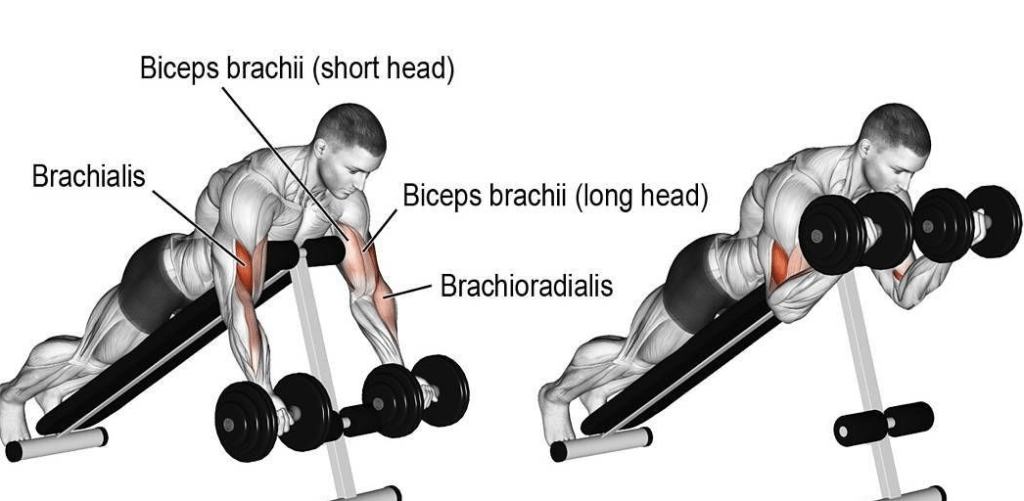Spider curls are a great exercise for building biceps as they produce an intense muscle contraction during each rep. Thus, they are a must to include in your daily workouts. Here, we will discuss more the muscles involved, the form as well as some tips to improve your workout.

What are Spider Curls?
Spider curls are a sort of curl in which you raise your chest on a bench to work out the short head of the bicep muscle. A great benefit of this type of curl is that by removing your bodyweight from the equation, you lose any support from the momentum you may have had during your bicep curls.
Spider Curls Work on Which Part of the Bicep?

The bicep has two heads: the short head and the long head. Both heads originate from the shoulder and combine to make the big muscle that attaches to the forearm.
The long head bicep muscle allows the forearm to flex and turn, while the short head of the bicep stabilises the shoulder joint when carrying large objects.

Spider curls target the biceps brachii short head, thus, adding shape to your upper arms. Additionally, they also work your forearm flexors.
Click on this link to view article about Surya Namaskar by Podium School
What are the Benefits of Spider Curls?
- Lifters who perform the same exercises repeatedly will work the muscles in the same way. This is why some people reach a plateau and can not seem to get their biceps to get much larger, even while lifting greater weights. If this describes you, then alternative workouts may provide greater results. Exercises such as the spider curl will help to fill up the biceps and increase muscular growth.
- The main advantage of executing spider curls is that having your arms stretched from the starting position allows for a longer duration under stress. This causes more metabolic stress, which in turn leads to an increase in the size of the biceps.
- Furthermore, the peculiar posture of the barbell spider curl provides a broader range of motion, thus, increasing movement efficiency, injury avoidance, and a greater possibility of strength as well as size growth.
- As you perform the exercise with dumbbells, you correct whatever strength imbalances you may have in one bicep against the other.
- While there is a lot of emphasis on building the bicep peak through workouts that focus on the long head, using exercises that exercise the short head like the spider curl will give the arm a more symmetrical look. Additionally, because the two heads of the bicep are fundamentally linked into a single muscle, if one is not exercised evenly about the other, there will be a muscular imbalance both visually and in terms of performance.
How to Perform Spider Curls?

- To begin this exercise, set the bench to an incline as though you were doing an incline bench press action. Place the barbell you’ll be using directly in front of the bench.
- Position yourself on top of the bench, pressing your stomach and front torso against it. As you grab the barbell in front of you, make sure that both feet are firmly planted on the floor, thus fully stabilizing your body.
- You should grasp the barbell with your palms facing upwards, just like any other conventional bicep curling action.
- As you breathe out, lift the barbell as high as you can. Squeeze the working bicep muscle and hold for a few seconds once you’ve reached the maximum contraction. Similar to other bicep exercises, avoid allowing your elbows to flare outwards throughout the action.
- Then, lower the weights to the starting position in a methodical way. This complete range of motion is one repetition.
Mistakes
It is difficult to cheat during the spider curl since you are working against gravity on the bench press. However, this does not rule out the possibility that you are making some errors.
Avoid a lack of contractions
The contraction of the spider curl is sometimes overlooked due to excessive velocity and weight being exerted. While it is vital to gradually increase the weight during your workout, it is far more crucial to be able to provide significant stimulation on the muscle as well. To do this, consider lowering the weight and focusing on a proper tempo with a brief pause as well as a squeeze at the peak of the contraction.
Range of motion
Because your body isn’t in the way during a spider curl, you have a full range of motion as the dumbbell has to be lowered almost to the ground.
This should be capitalised on and exploited. Neglecting a whole range of motion will result in just half the advantages, as well as less of a contraction, less fine stimulation, and ultimately less of an efficient movement. To avoid this, mentally tell yourself to fully descend and extend it before curling back up. Another solution is to always have a training partner with you to favourably evaluate your form during the workout.
Variation
It is critical to vary your arm training regimen to keep your body from growing bored with it. There are a few variations of spider curls, which we will discuss in the next section.
Feet Stance
Because of the spider curl’s unconventional positioning, you might lose balance and stability if your feet are not firmly planted on the floor. To avoid this, before completely lowering yourself onto the bench, firmly put your feet into the ground and ensure they are comfortable enough not to slip throughout the activity.
Click on the link to read about exercises for kids
Variations
There are two spider curl varieties. In most cases, folks will use a barbell or an EZ bar instead of dumbbells.
Making use of a barbell

The set-up and movement pattern are identical to dumbbells. The barbell is popular because it is simpler to overload with heavier weights, although dumbbells are excellent for correcting strength imbalances.
Making use of an EZ bar

Because of its wavy handle, the EZ bar will work your biceps even more, and it is also a joint-friendly grip. If you have wrist difficulties, this is the technique to use.
Performing Spider Curls
Keep a slow and even pace
This action doesn’t have to take long, but it should be done at a steady pace. This is not an explosive action; the more time you spend under strain, the more bicep muscle you will build.
Additionally, the tension will cause the muscle to adapt, causing it to break down not only type I fibres but also smaller type II fibres. The end effect is remarkable improvements with only a few seconds of work.
Use a fat grip to activate more muscles
Choose a barbell with a thicker bar, or put a towel around your barbell or dumbbells. A fat grip will improve your entire arm, from your hands to your shoulders. It will increase muscular activation in all arm muscles and, to a lesser extent, the entire upper body.
Allow your forearms to do the heavy lifting
Keep your shoulders and upper arms from performing the heavy lifting. When raising the weight, make sure just your forearms move.
Start with lesser weight
If your upper arms are assisting in the lift, it is likely that your weight is too heavy. Start with less weight and gradually increase to a greater weight so your form does not suffer.
Keep it for last.
The spider curl, as an isolated exercise, is best saved until the finish of your arm session. Compound exercises should be performed initially, followed by isolated workouts.
Maintain a rigid torso
Once you have positioned your body on the bench, make your torso stiff. Squeeze your glutes and breathe to push your abs into the bench. Your spine will remain neutral throughout the activity if you maintain this stance.
Don’t forget to maintain your mid- and upper-back muscles firm as well. This will protect your shoulders from drooping forward and your upper arms from shifting.
Don’t forget about the squeeze
Pay attention to your muscles while you raise the barbell or dumbbells. Feel the heat in your biceps as you raise the weight. Pause at the peak and let that squeeze further stimulate the bicep.
It just takes a second or two to squeeze the bicep at the top of the action, but it’s critical for optimum results.
Change your grip
Change your grip if you wish to engage the long head of the bicep. When performing the spider, moving your grip closer together will stimulate the whole bicep muscle.
Weight and Rep range?
We recommend using weights that you can comfortably lift approximately 10 times. Because you’ll be performing this as a finisher, it should be lighter than normal.
Workouts
The finest arm workout will engage both bicep heads. It will also work the forearm and hand muscles. Here are some workouts you can follow.
| Workout routine | Repetition | Weight |
| Warm-up for a few minutes with arm swings, jumping jacks, and a plank position. | ||
| Barbell bicep curls | 8 to 10 repetitions for three sets | Moderate weights |
| Incline dumbbell curls | 12 to 15 repetitions for three rounds | Light weights |
| Standing bicep cable curls | 8 to 10 repetitions for two to three sets | Medium to heavy weights |
| Hammer curls | 10 to 12 repetitions for three sets | Moderate weights |
| Concentration curls | 12 to 15 repetitions for three sets | Light to moderate weights |
| Spider curls | 12 to 15 repetitions for three sets | Light to moderate weights |
| Take a few minutes to calm down before wrapping up your arm day |
| Workout routine | Repetition |
| Incline curls | 3 sets of 8-10 repetitions |
| Barbell curls | 3 sets of 6-10 repetitions |
| Spider Curls | 2-3 sets of 10-12 repetitions |
Final Thoughts
The spider curl is an excellent isolation exercise that targets the biceps’ short head. A simple grip modification brings the long head into play, turning this into a full-body bicep exercise.
If you’re going to include the spider curl in your arm day, save it for the end. Additionally, if your bicep muscles aren’t even, use dumbbells. On the other hand, if you already have arm symmetry, use the barbell.
FAQS
What is the difference between preachers and spider curls?
Preacher curls and spider curls essentially have opposite resistance curves. In other words, they each have different sticking points. While spider curls are most tough when your biceps are fully clenched, preacher curls are most difficult at the first part of the concentric, when your elbows are near full extension.
If you have plenty of gym equipment at your disposal but just fancy a change from spider curls, then preacher curls are a fantastic alternative.
Additionally, even if you don’t have access to a preacher pad, you can still take advantage of this popular exercise by performing it over an incline bench.
What are some other types of bicep curls to perform with spider curls?
– Concentration curls

Works on the bicep’s long head to strengthen the bicep muscle.
Finishing your arm day with isolation techniques is a great approach to train the complete bicep muscle. Consider adding a spider curl to the short hair and a concentration curl to the long hair.
Hammer curls

Strengthens the grip and works the long head of the bicep and forearm muscles. The underhand grip gives this a better option than the normal bicep curl. This exercise would go nicely with the spider curl to target both heads of the biceps as well as the forearm muscles.
Zottman curl

This exercise works both heads of the biceps as well as the forearms’ brachioradialis muscle. The Zottman curl consists of a regular curl followed by a reverse curl. Depending on your goals and the other exercises in your arm regimen, Zottman curls might be a great option.
Bicep Curl with Band

Band-resisted workouts assist you in breaking through plateaus. For example, during a bicep curl, you activate the biceps more near the top part of the action than the bottom half. You can better match the strength curve of the exercise by using a band since the resistance is easy at the bottom and gets tougher as you climb.
Why are spider curls so difficult to perform?
Through a dead hang and vertical posture of both arms, spider curls strengthen good elbow flexion mechanics. Additionally, because of the downward pull of gravity, it is exceedingly difficult to drag the shoulder upward into flexion.
What are some alternatives to spider curls you can perform at home?
All of these spider curl variations can help you increase the size and strength of your biceps. The ideal option for you is primarily determined by your equipment availability and personal preferences.
Bent over curls

Bent over curls are a basic muscle-building workout that you can do any place you have access to free weights.
Dumbbells are the preferred exercise tool because they allow you to guarantee that both biceps receive equal effort, which helps to minimise the development of muscle imbalances. However, if all you have is a barbell, that’s okay too. The most essential thing is to utilise the proper form.
Begin by using an underhand grip to grasp your weights. Then, bend your knees and rest your elbows on your knees. Curl the weights toward your shoulders and contract your biceps as hard as you can. Hold the contraction for a second, then finish the exercise by slowly lowering the weights until your elbows are fully extended. Perform 3 to 4 sets of 10 to 15 repetitions.
The angle of this exercise is extremely similar to that of a spider curl. Thus, you will feel a strong bicep contraction at first, and then the resistance will start to feel lighter as you drop the weight.
up-in-arms-workoutDrag curls
Drag curls are the most basic dumbbell spider curl option since they are so easy to set up. You only need some free weights and a place to stand to execute this workout, so you may do it at home or outside.
The goal is to draw the bar or dumbbells up to your body by narrowing the gap between your forearms and biceps. In practice, you should draw your elbows behind your chest while moving the weights toward your shoulders.
Curls on the couch

Spider curls may be performed from the comfort of your own home if you have some free weights and a couch.
You could begin by placing some weights on the edge of your sofa. Then, lying stomach-down on the sofa, hang your arms over the armrest. Then, grip the weights and brace your arms against the armrest’s side. Curl the weights toward your front delts to start the rep. Hold the contraction for a second, then slowly lower the weights back down until your arms are completely extended.
You should preferably keep to high repetitions on this exercise because if the weight is too heavy, it may place too much strain on your lower back.
Curls in a chair
Chair curls are an excellent alternative to spider curls since they are quite handy and simple to do. You should ideally select a computer chair with plenty of cushioning so that you can brace your arm against it efficiently. You will also need a dumbbell for this workout so you may balance yourself by holding onto the chair with your other arm.
Begin by holding the dumbbell in an underhand grip. Then, stand behind a desk chair and brace the arm that is supporting your weight on the backrest. Squeeze your biceps hard as you curl the dumbbell toward your shoulder. Enjoy the tightness for a bit, then slowly drop the weight until your elbow is locked out.
Remember to repeat the move with your opposite arm to avoid developing muscle imbalances.
Which spider curl alternative is the most effective?
If you simply have a few pieces of equipment, sofa curls or bent-over curls are generally the best options because neither requires a bench.
How to perform bicep curls?
Choose dumbbells that you can lift 10 times with excellent technique. Starting weights for dumbbells are 5 pounds or 10 pounds. If you are just starting, recovering from an injury, or returning to exercise after a period of inactivity, you can start with 2-pound weights.
Start by standing tall with your feet hip-width apart. Maintain your abdominal muscles’ engagement. Then, hold a dumbbell in each of your hands. Allow your arms to hang down by your sides, palms facing front. Bend at the elbow and lift the weights such that the dumbbells are near your shoulders while keeping your upper arms steady and shoulders relaxed. Keep your elbows tucked up tight to your ribs. Additionally, while raising the dumbbell breathe out slowly. Finally, return the weights to their original positions. Perform 8–10 curls, then rest and repeat one or two more times.
Share with your friends





